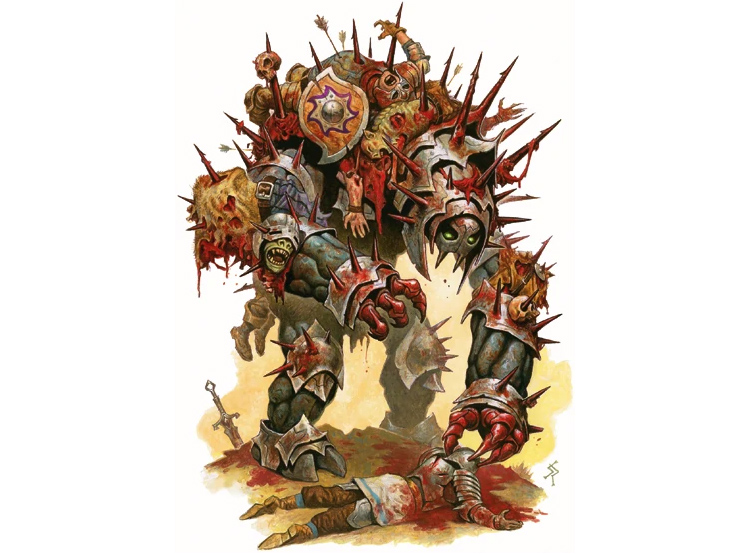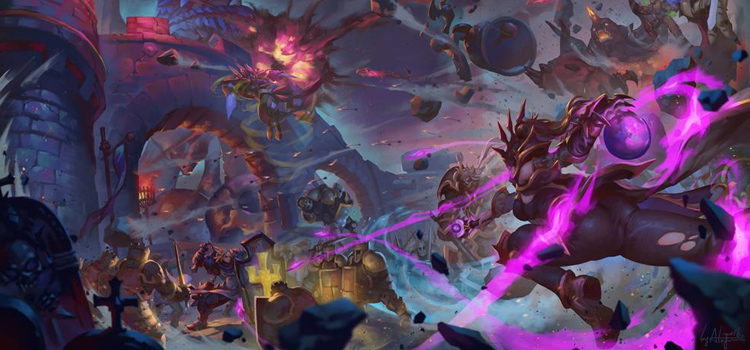D&D 5e: Most Underrated Monsters In The Game
This post may contain affiliate links. If you buy something we may get a small commission at no extra cost to you. (Learn more).
There are many monsters in Dungeons and Dragons. And some are so iconic that, despite them being quite dull, they’re still used because they’re so well-loved.
Taking a step back and looking at the more obscure monsters can make encounters much more interesting and challenging. Many monsters are both thematically and mechanically interesting, but are buried deep into the Monster Manual.
In this list I’ll do my best to highlight some of the monsters that I feel aren’t being used enough in campaigns. Some might be a little too powerful for their intended challenge rating, but that might be what’s needed to spice up your future D&D sessions.
10. Sahuagin

Sahuagins are a mainstay for anyone’s ocean or water themed campaign.
Though Sahuagins are mostly throwaway monsters, their stat blocks are perfect for murdering any party.
Any creature that isn’t at full health when fighting these deadly creatures activates the Sahuagin’s Blood Frenzy. Since they mostly attack in groups and have multiple attacks each, a fight with a Sahuagin could turn deadly if a party underestimates these ocean dwellers.
Not even a high AC build would be safe, as Sahuagins could fish for some good rolls and even critical hits.
9. Intellect Devourer

While an Intellect Devourer has a small health pool and horrible Armor class, it can annihilate an entire party of high leveled characters when utilized right.
It can even drop someone’s Intelligence to 0 at the very first round.
If an Intellect Devourer was hidden well, the party wouldn’t even know what happened until it was too late. One of these can be deadly if it’s stealthy, but an entire swarm can obliterate almost any party.
Once they take control of a creature, the Intellect Devourer acts as a spy for their Mindflayer masters too. Spooky stuff.
8. Grey Ooze

Like Rust Monsters, Grey Oozes destroy metal.
Their slimy, acidic surface will melt any weapon that it comes into contact with, making any warrior flee at the sight of a Grey ooze.
Oozes in general move very slowly. So they rely on blending into their environment to ambush their victims.
One could simply run away, or if the creature must be put down, it should be dealt with from a distance. Like with spells or ranged attacks.
7. Rust Monster

Rust Monsters are a classic Dungeons and Dragons creature. These terrify even high-leveled characters, not because of their potential to damage a player, but because of their ability to destroy any and all metal that they come in contact with.
A Fighter with a gleaming sword or a Paladin with shining armor would tuck their tails between their legs and run at the sight of even a few Rust Monsters.
If they stand and fight, they’ll surely regret it.
But any Rust Monster’s motive is to fill their stomachs. So throwing some scrap metal or daggers should be enough to distract them.
Any adventurer should use this opportunity to escape.
6. Quickling

Quicklings are incredibly hard to kill. And honestly, a little too strong for a Challenge Rating 1 monster.
They have high AC and all attacks made against will be at a disadvantage, because Quicklings have Blurred Movement.
Not only are they hard to hit, but Quicklings can make three attacks per round with a +8 to hit and are four times faster than most characters at 120ft. So not only can they stab people full of holes, but their victims won’t be able to run away easily.
5. Swarm of Rot Grub

A Swarm of Rot Rub can easily kill off level 20 characters.
They may not have great attack modifiers, nor is their damage impressive. But if they do land a hit and aren’t killed by the end of the next turn, they dig into their victim’s skin and can’t be harmed.
From this point on, they can dig deeper into their victim’s body and even into the heart, instantly killing their host. Yikes.
If the party doesn’t have a Paladin or a Cleric with Cure Disease, it’s over for that character. Infestation is a death sentence at any level.
4. Catoblepas

A Catoblepas is a large monster with a large health pool to match. Its Stench poisons everything within 10 feet, and anyone who doesn’t pass the high DC now has disadvantage on attack rolls.
After its foul smell, its tail attack does a whole lot of damage and forces yet another high DC saving throw, or the target is stunned.
If that weren’t enough saving throws to make, it also has a Death Ray. What’s that, exactly?
If it brings its target to 0 health or the target fails their saving throw, they’re dead. Fun.
3. Shadow

Shadows may have a low Challenge Rating. But for each time they hit, they can bring their target’s Strength down by 4.
And once a target’s Strength is brought to 0, they’re dead.
Shadows are also incredibly resilient because of their resistance to most forms of damage.
If they’re not hard enough to kill already, a Shadow in an area with Dim Light or in Darkness can hide as a bonus action to potentially make every attack an advantage. They also seem to pop out of nowhere, as they can squeeze into small spaces.
A group of Shadows can quickly make short work of a party if players don’t know how to deal with this creature.
2. Banshee

Banshees are terrifying creatures that can kill a party in a single round. Their infamous wails have a 30ft radius that forces those in its area of effect to make a saving throw, or drop dead.
This is especially deadly at lower levels, as the likelihood of someone dropping dead because of a Banshee’s wail is rather probable.
Approach one with caution, and if possible, some way to deafen the party.
1. Cadaver Collector

Cadaver Collectors are big, evil constructs.
Their name gives their motive away: they collect cadavers.
With a large pool of Hit Points, immunity to poison, necrotic, psychic, and non-adamantium weapon damage as well as resistance to magic, they’re really hard to take down. Even despite their low Intelligence score.
Cadaver Collectors deal with their targets with a paralyzing breath weapon. But their real bread and butter is their ability to summon the souls of the cadavers they collected.
There is no limit to how many souls they can have summoned at one time. So Cadaver Collectors could essentially have a specter speak for them while they’re focused on collecting more cadavers.






